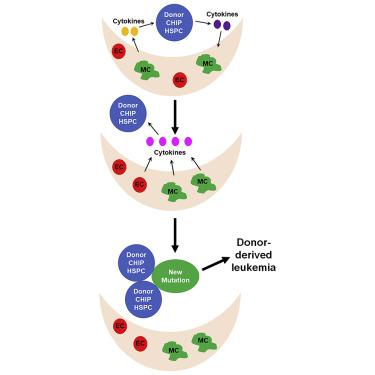Stem Cell Reports ( IF 5.9 ) Pub Date : 2020-08-11 , DOI: 10.1016/j.stemcr.2020.07.008 Sarah S Burns 1 , Reuben Kapur 2

|
Hematopoietic stem cell transplantation (HSCT) is a critical treatment modality for many hematological and non-hematological diseases that is being extended to treat older individuals. However, recent studies show that clonal hematopoiesis of indeterminate potential (CHIP), a common, asymptomatic condition characterized by the expansion of age-acquired somatic mutations in blood cell lineages, may be a risk factor for the development of donor-derived leukemia (DDL), unexplained cytopenias, and chronic graft-versus-host disease. CHIP may contribute to the pathogenesis of these significant transplant complications via various cell-autonomous and non-cell-autonomous mechanisms, and the clinical presentation of DDL may be broader than anticipated. A more comprehensive understanding of the contributions of CHIP to DDL may have important implications for the screening of donors and will improve the safety of HSCT. The objective of this review is to discuss studies linking DDL and CHIP and to explore potential mechanisms by which CHIP may contribute to DDL.
中文翻译:

潜在的克隆性造血功能是供体来源的白血病的新型危险因素。
造血干细胞移植(HSCT)是许多血液学和非血液学疾病的关键治疗方式,目前正扩大其治疗范围。然而,最近的研究表明,不确定潜能的克隆性造血(CHIP)是一种常见的无症状性疾病,其特征是血细胞谱系中年龄获取的体细胞突变的扩大,可能是供体源性白血病(DDL)发展的危险因素。 ),无法解释的血细胞减少和慢性移植物抗宿主病。CHIP可能通过各种细胞自主和非细胞自主机制促成这些重大移植并发症的发病机理,DDL的临床表现可能比预期的更广泛。对CHIP对DDL的贡献的更全面的了解可能对筛选捐赠者有重要意义,并将提高HSCT的安全性。这篇综述的目的是讨论将DDL和CHIP联系起来的研究,并探讨CHIP可能有助于DDL的潜在机制。











































 京公网安备 11010802027423号
京公网安备 11010802027423号